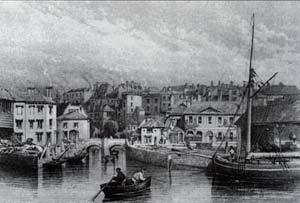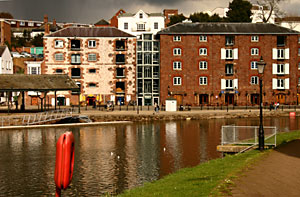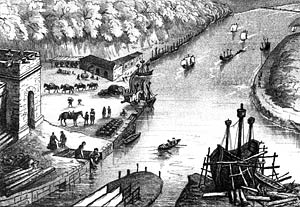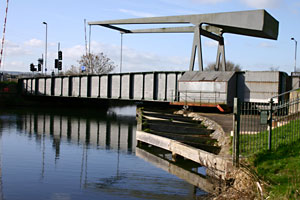
- Home
- Memories
- Scrapbook ▽
- Topics ▽
- People ▽
- Events
- Photos
- Site Map
- Timeline
Page updated 11th December 2013
When the Romans arrived in Exeter, they used Topsham as a port, even though the Exe was navigable as far as Exeter. However, there is evidence that a natural sandstone ledge was used to load and unload boats beneath the Roman wall. The city received trade at the quay from this time, and even suffered Viking raiders who could navigate up to Exeter.
In the 1284, the Countess Isabella de Fortibus, an early member of the Courtenay family built a weir across the river above Topsham, leaving a 30 ft gap in the middle. This was to run her mills on each side of the river. In 1311, Hugh de Courtenay blocked the central section, preventing boats from sailing up to Exeter, stopping the tidal movement up to the city and forcing the boat owners to unload in Topsham. From that time the city and the Courtenay's were constantly arguing about the loss of navigation.
When Henry Courtenay, who controlled Countess Wear and Exe Island, was detained and executed in 1538 for conspiracy, all his lands were confiscated by King Henry VIII. Two years later Exeter was finally granted permission to open up Countess Wear for navigation - however, the river had heavily silted up and it was found to be not practical. In 1550, Exeter was granted by the young Edward VI, the right to Exe Island, and the development of the river frontage started.
In 1563 it was decided that a canal should be built, linking Countess Wear with the city. John Trew was engaged to build the canal for £5,000 and a start was made in 1564 to survey the eastern side of the river - within a short time work stopped because the rock was too difficult. Trew switched to the western side of the river and by 1566 the canal was complete. It was 2,850 m long, 5 m wide, 1 metre deep and had a new, Trews weir to raise the water level at the city end. This was the first pound lock canal in the country - at last Exeter could develop its quay for trade. In the 16th century the quay, or 'keye' was much shorter than today so work commenced to lengthen it and install the Watergate in the city wall, probably on the site of an earlier 'Watergate', to facilitate access between the quay and the city. The canal was not as successful as expected due to its shallow draught and Trew made little profit from the venture. The first purpose built transit shed for goods appeared around about 1564. This would evolve into Quay House. This link also shows how the land was reclaimed at the quay.
It was during the late 17th century that the quay was extended down river to 147 metres long, to a point adjacent to the far end of what would be Colleton Crescent. The canal was extended to Topsham in 1676, now allowing 16 ton barges to traverse the canal. The amount of trade brought into Exeter from around Europe grew and in 1681 it became necessary to construct a purpose built Customs House - this was the first building in Exeter to be completed in brick. It had a colonnaded front giving access to a storage space for the assessing of goods in wet weather and space above for records to be kept and to house the customs men. It was on 20th February 1486 that Dartmouth, Plymouth and Topsham were ordered to erect their first 'le kinge's Bemes' to regulate and tax trade. The Kings Beam is a successor to the original and was installed for the weighing of goods so that duty could be calculated. The 'King's Pipe' was found in the Custom House to burn contraband tobacco. At this time the quay was enlarged so that '100 sail of ship may safely ride therein'.
In 1698 one William Bayley was employed to widen, deepen and extend the canal once again. Unfortunately, Bayley embezzled the funds and fled - it was another 26 years before the canal was completed, at a cost of £20,000, to 4 miles long, 18 m wide and 3 m deep. The canal could now take ships up to 150 tons all the way up to the quay. The City Chamber purchased Topsham Quay in 1769, enabling them to control trade from both ports.
Trade with the continent expanded beyond wool for the Dutch and now included continental ports in Portugal, Spain and Italy. At least one Exeter fortune was made from the wine trade from Portugal and Spain.
During the 18th century, Exeter became an affluent little city on the back of the wool trade with the Dutch and from time to time, other parts of Europe. Exeter serge was so popular that wool had to be imported from Ireland to feed the industry. The fulling mills were working at capacity and much of the western side of the city along the river was taken up with racks to dry the wool - Shilhay, Exe Island, Bonhay, and Friernhay, on what is now Colleton Crescent were all given over to the rack fields. The Georgians added many interesting buildings including the hospital in Southernhay in 1741, and Colleton Crescent in 1802, which overlooks the quay. Situated at the top of the sandstone cliffs that backed onto the newly extended quay, the Crescent gives fine views over the river and canal basin. Beneath the cliffs are brick arches leading to dry storage for the expanding quay.
Trade continued to grow and the city authorities spent in excess of £100,000, extending the canal. The engineer James Green advised the city to extend the canal to Turf Locks and build a canal basin which was completed in 1830. Known as the New Cut, there is a large semicircle cut out of the parallel sides to allow the turning of large boats. Green also installed the first swing bridge at Countess Wear. Unfortunately, the cost to the City was to be a burden for many years after. Two new 5 storey warehouses, one for Messrs. Hooper and one for Robert Cornish, were also constructed on the old quay in 1834-5. Such commodities as Danubian corn, Swedish timber and coal from the north of England were unloaded onto the busy quayside.
In 1844 the railway reached Exeter and an increasing amount of trade came in along Brunel's GWR or 'God's Wonderful Railway'. Large debts had been accumulated by the city authorities on extending the canal, quay and basin, and the loss of revenue to the railway inevitably led to a slow deteriation in use of the canal. Even the arrival of the Alert, the first driven by steam, at the canal basin in 1840 could not save the canal from its decline.
In the 20th century, trade continued with petrol, oil, timber, coal, cement and even potatoes passing through the port. However, the loss of the woollen industry meant that exports dropped significantly.
One warehouse was used to store French onions, along with a gaggle of onion sellers and their bicycles. 'Onion Johnnies' would arrive by boat from Roscoff, carrying their loads of onions. When a group arrived, one half would be given the role of making up the 'troches' or strings of onions, being careful to display well the Pen Capitaine, or the best quality onions to greatest effect. A 'troche' of onions would weigh 100 kilos. These were then taken onto the streets and byways of England on a bicycle, and be sold, door to door. The first pre-bicycle Onion Johnny is said to be Henry Olivier who first arrived in England in 1828. They would enter England through various ports and travel the length and breadth of the country, including Scotland. See Marcia's Exeter for more on Onion Johnnies and photos.
In 1972, the BBC saw the potential of Exeter quay as a location for their new drama, the Onedin Line. Resembling 19th century Liverpool, the quay was used extensively along with Colleton Crescent for exterior shots. The canal basin housed the Maritime Museum, but this closed in 1997. Now the City Council is trying to find a use for many of the redundant warehouses around the basin. Much of the quay area has been regenerated and it is a popular destination for tourist and locals alike. Now the quay receives no shipping along the canal and the only boats frequenting the 16th century quay are pedaloes and canoes, and an assortment of yachts and pensioned off trawlers laid up in the canal basin. Oh yes, there's also Butt's Ferry for those too lazy to walk over the bridge!
The canal has two notable inns that are thriving, especially in the summer months. The Double Locks, about a mile down the canal, is a popular destination for students and young people. At the mouth of the canal is the Turf Lock Hotel, which can only be visited after a brisk walk along the canal bank to work up a thirst. There are beautiful views across the estuary to Topsham and down to Exmouth.
Anyone who is interested in the history of Exeter or in industrial archaeology should spend some time exploring Exeter quay and canal. Otherwise, just visit for a pleasant walk and drink.
 Exeter quay
and Custom House, 1855.
Exeter quay
and Custom House, 1855. Exeter
Quay and warehouses. Photo David Cornforth
Exeter
Quay and warehouses. Photo David Cornforth The quay as depicted in An Account of Exeter's Merchant Adventurers. Notice the ship building on Shilhay. Click to enlarge.
The quay as depicted in An Account of Exeter's Merchant Adventurers. Notice the ship building on Shilhay. Click to enlarge. Kings Arm Sluice with the canal in the foreground and the river beyond - circa 1900. Click to enlarge.
Kings Arm Sluice with the canal in the foreground and the river beyond - circa 1900. Click to enlarge.  Exeter quay, 2004, from Colleton. Photo David Cornforth
Exeter quay, 2004, from Colleton. Photo David Cornforth  The Turf
Locks Hotel, built by James Green. Photo David Cornforth
The Turf
Locks Hotel, built by James Green. Photo David Cornforth  Countess Wear swing and bascule bridges across the canal - Photo David Cornforth
Countess Wear swing and bascule bridges across the canal - Photo David Cornforth  Butt's Ferry, Exeter Quay -
Photo David Cornforth
Butt's Ferry, Exeter Quay -
Photo David Cornforth
│ Top of Page │